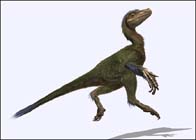New species of dinosaur unearthed in Germany
Fossils from a hitherto unknown species of a 150 million-year-old dwarf dinosaur have been found in northern Germany, scientists said Wednesday.

Initially they suspected that the remains from more than 11 sauropods were from young dinosaurs. But an analysis of their bones showed they were small adults that probably lived on an island during the late Jurassic period.
"It is the first case of island dwarfing proven for sauropod dinosaurs," said Professor Martin Sander of the University of Bonn in Germany.
Sauropods were the largest animals that lived on Earth. With their long necks, massive tails, small heads and stout legs they weighed on average about 20 tons and measured 20 yards in length. The biggest grew to 80 tons and were as long as 40 meters.
By contrast, the new dwarf species, called Europasaurus, was a mere 1 ton and about 6 yards long--about the size of a small rhinoceros or a big buffalo, reports ZDNet.
Accordingh to New Scientist: "It's the first time we've really proven [that the fossils are from a dwarf species]," says Martin Sander, a palaeontologist at the University of Bonn, Germany, and one of the team who described the new species.
The proof comes from examining thin sections of the fossilised bones for growth marks. As an individual ages and bone growth slows, these growth marks get closer and closer together - a distinctive sign of adulthood. Sander and his colleagues are the first to use this technique on dwarf dinosaur bones (Nature, vol 441, p 739), and it revealed that the smallest individual, thought to be a juvenile, reached 1.7 metres long, while the largest fully grown adult stretched 6.2 metres. "I think it's a very powerful technique," says Peter Dodson, a dinosaur expert at the University of Pennsylvania, Philadelphia, who was not involved in the study.
David Weishampel of Johns Hopkins University School of Medicine in Baltimore, Maryland, who has extensively studied dwarf dinosaurs, agrees that the technique raises the bar for assessing dwarf species. But he believes that existing evidence based on bone texture and other clues was enough to be convincing.
By comparing the size of the bones of the dwarf dinosaurs with their closest ancestors and descendants, the scientists determined how old they were.
The smallest upper leg bone they analysed was 16 cm (6.3 inches) in length and the biggest 50 cm. Dwarf dinosaurs with 50 cm leg bones were fully grown but in other species that would have represented a young animal.
Their closest relatives had femurs measuring 1.5 -2 metres, according to the scientists, nforms Reuters.
O.Ch.
Subscribe to Pravda.Ru Telegram channel, Facebook, RSS!


